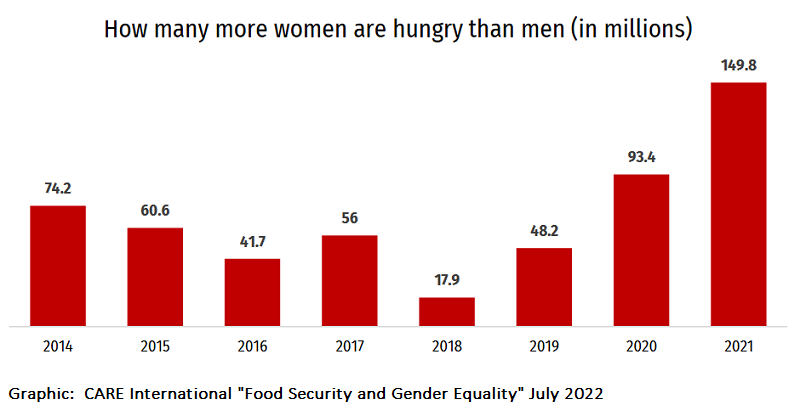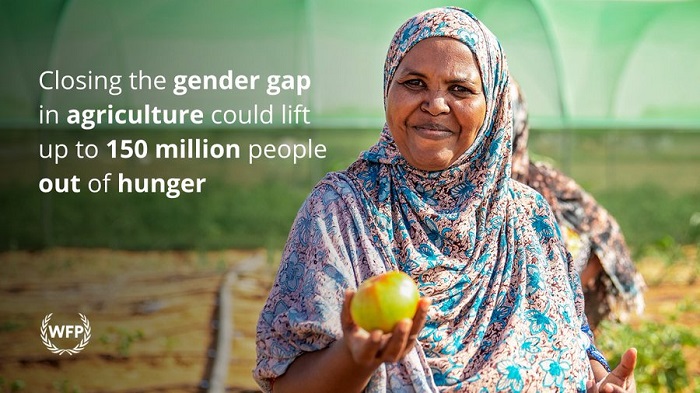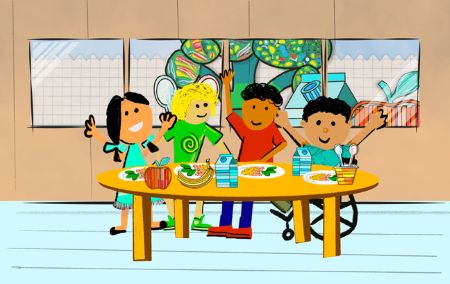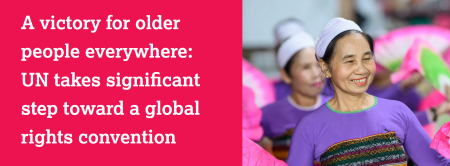

Hunger is not an equal-opportunity affliction that affects women and girls and men and boys in equal measure. The sad fact is that women and girls are hungrier. Worldwide, women are more likely to live in extreme poverty and to be food insecure compared to men. The State of Food Security and Nutrition in the World 2022 reports that women have less food than men in every region in the world. And, disturbingly, the gap between men's and women’s food security is growing rapidly. Between 2018 and 2021, the gap between the number of hungry women and the number of hungry men increased by more than 8x, with a staggering 150 million more women than men hungry in 2021. 1

Why is this so?
It comes down to inequalities of power and access to resources, reinforced in many cultures by entrenched gender norms. Women often lack power in their households and in their societies. Gender inequality is widely recognized as an axis of nutritional inequality. 2
Here are some areas in which gender inequality has a major impact on food security:
Family Life
Despite women being responsible for 90% of preparing and buying food, in countries facing conflict and hunger women are often eating last and least. In some countries, gender norms mean women eat last, after all the men and boys have been fed. Gender relations in some cultures can also influence which children go hungry, as families forced to ration meals will favour boys, who are seen as future breadwinners, over girls, who are considered burdens on the family until they marry and leave. And when a crisis hits, women are usually first to sacrifice their own food to ensure their families have enough. Many times, they have the most responsibilities in the home, but the smallest amount of food.
Lack of Women's Rights and Representation
In many countries, women have fewer rights than men, lower status, and less power. This inequality directly affects hunger and nutrition not only at the family level, but also at community and national levels, where, for example, decisions about agriculture and food-trade policy take place, often without women's voices being heard.
Man-made Conflicts
Armed conflict is the #1 driver of hunger on the planet. Conflict disrupts economic activity and food production, as farmers are displaced from their land or are too terrified to tend to their animals or crops. Restricting access to food can also be a strategy of warring parties. Women are hardhit by the effects of conflict. Many women become the heads of their households when men leave to fight, or die at war, but they are often left with reduced income and few resources to be able to provide for their children. Women are especially vulnerable to sexual violence, abuse, and abduction during times of war. Women and children who must flee their homes are among the most vulnerable to acute food insecurity and malnutrition.
Agriculture
While they make up more than half of the world’s agricultural workers, women have less access to resources and services than men. Patriarchal gender norms create multiple disadvantages for women farmers, specifically in land rights (smaller plots, difficulties attaining ownership, discriminatory inheritance rights), lack of access to productive resources (such as credit, training programs, technology, and inputs such as seeds and fertilizer), and exclusion from decision-making and political representation. These inequalities negatively impact food production and food security for all. "There is overwhelming evidence that gender-based discrimination, or the denial of women’s human rights, is one of the major causes of poverty and food and nutrition insecurity. When women are empowered and have the same access as men to productive and financial resources, income opportunities, education and services, there is a consequent increase in agricultural output and a significant reduction in the number of poor and hungry people." 3

Gender Inequality Affects Everyone
"Women are a big portion of global food producers, and they are often the person in charge of feeding their families. But even so, gender norms and gender inequality put women’s own food security at high risk—as well as creating significant risks for their families, communities, and countries. Put bluntly, here is what the findings say: as gender inequality rises, people get less food to eat on a national scale. This holds true across more than half the countries in the world. ... To put it simply, the more gender inequality there is in a country, the hungrier and more malnourished people are." -- CARE International "Food Security and Gender Equality"
Dig Deeper...
Listen: Women are Disproportionately Affected by Hunger in Africa -- 18-minute segment of CBC Radio show The Current, first aired September 2, 2022.
Read: To Ease the World Food Crisis, Focus Resources on Women and Girls -- article published in the science journal Nature, August 2022.
____________________
Note: While this Small Sip focuses specifically on women and girls, GRAN recognizes that gender inequality and discrimination also significantly impact the lives, health, and food security of trans and gender-diverse persons around the world.
[This is the sixth installment in GRAN's Small Sips series on The Right to Food.]



